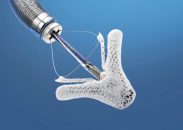According to this study, presented during the ESC 2019 scientific sessions, non-ST acute coronary syndrome (NSTE-ACS) patients treated with ticagrelor presented a significantly higher risk of bleeding than patients treated with clopidogrel, with no counterbalance by higher benefit in thrombotic events. Researchers suggest clopidogrel might be the gold standard for this elderly NSTE-ACS population, though…
Can We Treat Severe Residual Mitral Regurgitation after MitraClip without Surgery?
Courtesy of Dr. Carlos Fava. Edge to edge with MitraClip was shown effective and safe, and its outcomes have been improving over these past few years. However, one of its greatest challenges involves not being able to reduce mitral regurgitation (MR) after device implantation, resulting in the need for surgery, as some studies have shown…
Physiological and Clinical Changes After Tricuspid Repair
After the recent announcement by the US Food and Drug Administration (FDA) green-lighting transcatheter aortic valve replacement (TAVR) in patients across the whole spectrum, and given the advancements regarding devices already in the market (such as MitraClip) and a variety of pulmonary valves, there is only one territory left to conquer: the long forgotten tricuspid…
The Most Read Articles of July in solaci website
1-Though Systolic BP Seems More Important, Diastolic BP Should Not Be Disregarded Systolic hypertension is more often associated to cardiovascular events. However, diastolic blood pressure should not be disregarded, since it can also predict even worse outcomes. Read more HERE 2-After Much Toing and Froing, Gastrointestinal Protection Is Back to the Forefront Several clinical guidelines…
Permanent Carotid Coil Filters in Patients with Atrial Fibrillation
This new strategy to reduce the risk of stroke in patients with atrial fibrillation is technically feasible and safe, even though long-term outcomes are yet to be seen and despite the evidence available, for instance, left atrial appendage closure devices. It is true that they could be used simultaneously, but its synergy and cost have…
Impact of Edge to Edge Transcatheter Tricuspid Valve Repair
Reducing tricuspid regurgitation with transcatheter valve repair is associated to improved liver function, which is often ignored by many cardiologists. This is especially true in cases with deteriorated liver function prior valve repair. Instead, kidney function did not show any changes. Transcatheter tricuspid valve repair seems attractive especially in patients with liver failure. Edge to…
Surgery to Improve Survival in Isolated Tricuspid Regurgitation
Patients with isolated tricuspid regurgitation (i.e., who have no associated left-sided valve disease) are frequently treated conservatively. In many cases, valve disease is highly symptomatic, even with the optimization of medical treatment; however, an invasive strategy is seldom proposed. The aim of this work was to measure the impact of surgery on isolated tricuspid regurgitation…
Do NOACs Result in Any Benefit in TAVR?
Courtesy of Dr. Carlos Fava. The need for anticoagulation after transcatheter aortic valve replacement (TAVR) is over 15% according to different reports and, so far, no one has analyzed in depth whether new oral anticoagulant agents (non-vitamin K oral anticoagulants [NOACs]) result in superior benefit compared with classic vitamin K antagonists (VKAs). This study analyzed…
Angioplasty vs. Surgery in Lower Limb Ischemia
This analysis of data from an already published study, “Bypass Versus Angioplasty in Severe Ischemia of the Limb (BASIL-1),” confirms the superiority of bypass over balloon angioplasty, with or without stenting, in patients with chronic lower limb ischemia who require a femoropopliteal intervention. While analyzed interventions took place between 1999 and 2003 (a fact subject…
Mechanisms of Post PCI Persistent Angina
Angina persistence or recurrence after PCI can affect between 20 to 40% of patients in the short and mid-term. This might be true despite PCI optimization using FFR, intravascular ultrasound and the latest generation stents. This problem is associated with high healthcare cost, which can double in patients with recurrent or persistent angina compared against…









